
European
Nuclear Society
e-news
Issue 23 Winter 2008
http://www.euronuclear.org/e-news/e-news-23/status-and-patterns.htm

R. Khan, H.Böck
Vienna University of Technology, Atominstitut, Vienna,
Austria
The problem of a lack of qualified nuclear personnel has been recognised globally since the nineties due to the retirement of ageing workers, a lack of adequate replacement due a to a negative public perception of nuclear and a lack of interest from young people in starting a nuclear career. Europe, as an active promoter of nuclear education, has experienced this situation even in member countries which pursue a strong nuclear power programme. Therefore, to solve this problem, Europe along with the support of all stakeholders of nuclear technology, has taken a wide range of measures. These measures include the development nuclear education programmes at universities/research institutes, enhancing students’ and professors’ exchange programmes, and improving public information in the nuclear field at a local and European level. This paper describes the status and trends of nuclear education in European countries at both national and regional level. Furthermore, it refers to best practices being carried out in EU member states and summarises recommendations for further improvement.
Nuclear technologies play an increasingly important role in our everyday lives. For example, in nuclear medicine, nuclear techniques and radioisotopes are used for diagnosis, therapy and research. In many cases there is no alternative treatment. Agriculture also utilises radioisotopes in soil and water management, crop nutrition, plant breeding and genetics, animal production and health, insect and pest control, food and environmental protection.
There are 39 research reactors in Europe [8] being used in nuclear engineering teaching, training and research, reactor fuel development and radioisotope production. There are many other applications of research reactors, which are summarized in [16].
The IAEA Annual Report (2004) states that there are 1122 facilities operating under safeguards around the world. Taking this figure into account, the efforts needed to develop, sustain and promote nuclear applications [13] can be estimated.
The practical application of all the above mentioned fields and techniques, with their associated nuclides and equipment, obviously require a large number of qualified nuclear staff (i.e. nuclear engineers, radio-chemists, health physics staff). Clearly, the EU must continue to benefit from nuclear technologies and, therefore, needs properly trained professionals to work in these areas.
The present survey is divided into two parts. The first part surveys the present national & European status of nuclear education, while the second part describes the best practices being carried out and outlines some recommendations for further improvement of nuclear education.
Following some relevant national programmes and European efforts performed to improve and reinforce the teaching and training in Nuclear Education are presented. It is not possible, due to the limits of this paper, to cover all the existing programmes in Europe.
Austria does not operate any nuclear power plants. Its only interest to keep nuclear education alive is related primarily to environmental, health and safety concerns arising from nuclear power plants in neighbouring countries. In 1978, the legislation prohibiting a nuclear power plants on the Austrian territory was adopted as a result of a referendum, in November 1978, rejecting the nuclear power plant project Zwentendorf. However, the Austrian Research Centre Seibersdorf, University of Salzburg, University of Vienna have some disciplines of nuclear education. The Atominstitute of the Austrian Universities (ATI), which hosts a TRIGA Mark II research reactor, is the main contributor to nuclear education in the country and also Europe. The ATI is concentrates its research activities in the following fields [1].
Electron and X-ray physics
Nuclear and nuclear astrophysics
Nuclear technology, data processing & electronics
Low temperature physics & superconductivity
Neutron and solid state physics
Radiochemistry
Radiation protection and dosimetry
ATI runs three types of main activities - national, regional and international. National activities mainly cover academic and training programmes (i.e. Master and PhD). The European activities involve the participation in the ENEN Master of Nuclear Engineering and NEPTUNO project. International activities include the research contracts with the IAEA.
Figure 1 shows the evolution of students studying nuclear subjects (nuclear engineering, reactor physics and kinetics, radiation protection) offered at the ATI. The reason for this growing trend is the awareness level of students in the nuclear field and their interest in the nuclear discussion between Austria and its neighbouring countries.
European networks like ENEN or NEPTUNO to promote nuclear education and training attract the students to nuclear subjects. As a member of the ENEN Association (www.enen-assoc.org), Austrian students participate at the ENEN activities like the Eugene Wigner Course for Reactor Physics Experiments. The Public Information Materials Exchange PIME, an international conference organised by European Nuclear Society (ENS) to convince the public through print and electronic media of safe and efficient use of nuclear technology, also helps to raise the nuclear student enrolment rates in universities.
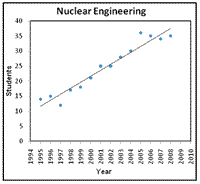 |
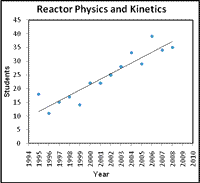 |
Figure 1: Historical view of nuclear education at ATI since 1995
The Atomic Energy Commission (Commissariat a l'Energie Atomique - CEA) was set up in 1945 and is the public R&D Corporation responsible for all aspects of nuclear R&D. Presently, the CEA operates 14 different types of research reactors, all started up between 1959 and 1980. About 17 units dating from 1948 to 1982 have been shut down or decommissioned [1].
Diploma in Nuclear Engineering: It is a typical French engineering degree equivalent to a Masters. It includes 5 to 9 month internship in the industry or an R&D organisation. Also special diplomas in nuclear medicine and radioprotection, e.g. a diploma in nuclear medicine, radio-pharmaceutics and nuclear medicine are awarded. The radioprotection diplomas involve the training of technicians in control, safety and the transportation of nuclear materials.
Masters and Doctoral Programmes: In close partnership with CEA labs and French universities, it offers both programmes in the following fields of:
Nuclear R & D, nuclear engineering
Fundamental physics and chemistry
Material science
Environmental science
Biology and medicine
Software science and simulation
Nanosciences
Fusion
About 40% trainees from CEA, 55% from nuclear industry & Small and Medium Enterprises (SMEs) and a few percent of international trainees participate in the professional training programmes. Some training courses award certificates. Here are the soecific areas of training offered:
Radioactivity measurements
PWR, operation, components, safety
Nuclear cycle, waste management
Materials and physico-chemistry
Decommissioning
Security, nuclear safety, quality management
Radioprotection
Radio-pharmaceutics, molecular biology, biochemistry
Renewable energy systems
Assistance for PhD students & managers
Innovation management
Education trainings
The INSTN cooperates with international organisations (IAEA, ENEN, EMIL, NEPTUNO etc) in education and training programmes. The other active nuclear education institutions involved are:
Grenoble Institute of Technology
Cadarche Research Institute
Many German universities and colleges of higher education were heavily engaged in nuclear education from 1970s to 1980s. Several important events (e.g. the Chernobyl accident, the anti-nuclear movement, etc.) politically affected nuclear policy. In 1986, the government passed a resolution to phase out nuclear power in the future. The R&D projects aimed at high-temperature gas-cooled reactors and fast breeder reactors were terminated after 30 years of promising work. The firm decision of the coalition government of 1998 was taken to initiate the nuclear phase-out programme and replace nuclear energy mainly with renewable energy sources until 2020.
The Alliance for Competence founded in April 2000 following the recommendation of a high ranking Commission under the Federal Ministry of Economy and Technology fixed the strategic goals of this Alliance as follows:
Evaluation of the evolution of training capacities and job development in the nuclear technology sector
Enhanced cooperation with universities and support of international initiatives (e.g. ENEN, WNU)
Co-ordination and concentration of the activities in publicly-funded nuclear safety and repository research
Support for qualified young scientists through third-party funding
Participation in the further development of international safety standards (EU, IAEA, OECD/NEA) but without government funding
The Alliance for Competence estimated in a survey that about 1200 more specialised staff will be needed until 2010 [5].
This trend was stabilised by the new government formed in autumn 2005, which kept the nuclear policy unchanged. On the other hand, due to the persistently weak economic situation in Germany and relatively high electricity costs compared to other European states, awareness of the need for an economical and reliable energy supply in the country has recently increased. This response renewed the discussion on the nuclear energy option.
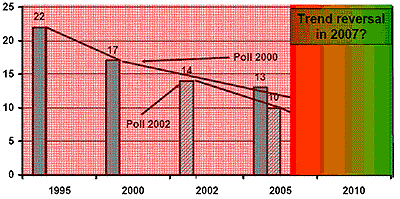
Figure 2: Trends of decline and relative stability in nuclear education courses between 1995 & 2010 [1]
For higher scientific and engineering education, a number of universities (including technical universities) and Colleges of Higher Education play a key role. Universities establish strong links between education and research. They offer diplomas and/or Masters degrees (minimum of 5 year study) and are entitled to award PhDs. On the other hand, institutions like specialised colleges focus on transmitting knowledge and skills for specific professions and offer diplomas ( “FH” = Fachhochschule) after 4 years of study. But they can not award PhD degrees.
All German universities offering nuclear education courses have changed or are changing their diploma programmes to a bachelor/masters programmes, but the general approach toward nuclear education remains unchanged. The future standard is a nuclear Masters of 3 or 4 semesters following a BA in engineering or natural science. The PhD programmes strongly link the universities with research centres.
These are the main centres of competence in nuclear technology in Germany:
In North Rhine-Westfalia, the Forschungszentrum Jülich and the University of Aachen are supported by RWE and GNS
In the Eastern part of Germany, the centre of competence is the Forschungszentrum Rossendorf and the universities of Dresden and Zittau/Görlitz, with the support by Vattenfall
In Bavaria, the Technical University of Munich and the GRS are supported provided by E.ON
The centre of competence in Southwest Germany consists of the Forschungszentrum Karlsruhe (FZK) Karlsruhe, Institute of Technology (KIT) , the ITU (Institute for Trans-Uranium Elements, Joint Research Centre of the EU), and the universities of Karlsruhe, Heidelberg, and Stuttgart, with the support of EnBW
The main topics of research being carried out in the Germany areas follows[5]:
. Safety research for nuclear reactors
Investigation of severe accident phenomena
Analysis of sequences of design basis and design extension conditions
Application to operating power plants
Improvement of off-site nuclear emergency management
. Safety research for nuclear waste disposal
Characterisation and immobilisation of nuclear waste
Reduction of radio-toxicity
Long-term safety of nuclear waste disposal
Transfer of R&D results to construction and operation of repositories
Radiation protection research
. Maintenance of competence / training / teaching
Operating nuclear power plants
Decommissioning nuclear power plants
Construction and operation of repositories
It should also be mentioned here that recently a number of professorial chairs at various German universities in the field of nuclear technologies have been or are being filled.
Hungary operates four VVER 440/213 nuclear power plants, which provide almost 40% of the current electricity demand. Construction started between 1974 and 1979, and operation between 1982 -1987. Due to its excellent operation record the Hungarian parliament’s economic committee decided to initiate a 20-year life extension project for the Paks NPPs (otherwise these NPPs would have had to close after 30 to 40 more years of operation).
The country relates nuclear education and training workforce demand to the construction of new NPPs and the operation and future of the existing nuclear power plants. Students specialising in nuclear power, radiochemistry, and nuclear measurement techniques have been educated at the Budapest Technical University and the KFKI research centre within the framework of technical and scientific educational programmes. With the IAEA's assistance, a nuclear maintenance centre was built and a new generation of instructors was trained as part of a project to improve the nuclear plant's professional training system and conditions. Future training needs are tied to future nuclear developments, including decommissioning, life extension, and the construction of new plants.
Hungary implements nuclear education as part of general curriculum of secondary schools for both nuclear and non-nuclear students. The recommended curriculum for secondary schools includes basic topics of structure of nucleus, radioactivity, nuclear fission and fusion. After secondary education, a certain number of students are financed by the state while the rest have to finance their education themselves. Until 2005, it took five years of study (equivalent to MSc level) for both engineers and scientists to qualify. After the 2005, the “Bologna Process” was newly implemented in universities for academic training. Since 2005, (engineers) and 2006 (for all students), universities started the three-year long BSc degree courses and two-year MSc degree courses. The following universities currently offer nuclear education for different applications [1]:
Budapest University of Technology and Economics (BME)
The University of Debrecen
The Roland Eötvös University Budapest
Semmelweiss Medical University Budapest
Pannon University of Veszpren
Other than these universities, the Paks NPP has its own education and training centre. This centre has two main training facilities, a full-scale simulator for operator training and a Maintenance Training centre for technicians and maintenance workers.
The Italian nuclear programme was largely stopped by a referendum in November 1987, about 18 months after the Chernobyl accident. Again in 2004, a newly-adopted Energy Law opened up the option of a joint course of action with foreign companies in relation to nuclear power plants and importing electricity from abroad. This happened due to clear change in public opinion, especially among the young generation favouring nuclear power for Italy. Today, Italy is the only G-8 country without its own operating nuclear power plant. As more than 10% of its electricity is imported, Italy invests in the construction of foreign NPPs, such as those at Flamanville/France and Mochovce 3&4/Slovak Republic.
ENEA is the most important agency for applied nuclear research in Italy. It focuses most of its R&D on decommissioning and waste. Basic research continues in order to maintain the nuclear option in the light of climate change concerns.
The number of enrolled nuclear engineering students increased up steadily up until the early 90s. After that, with some variations, the number decreased to an average of about ten per year in each of the Italian universities offering nuclear engineering degrees. The number of the nuclear engineering graduates has increased from about 300 in the early eighties and has stabilised at about 100 in the last few years.
Figure 3 represents the history on nuclear engineering students (graduates) in Italian universities from 1960 to 2001. This trend shows the peak value of graduated students in early eighties.
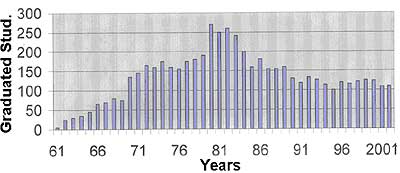
Figure 3: Annual variation trend of nuclear engineering graduate students in Italian universities [1].
The universities have updated their curricula so that well qualified engineers with enhanced knowledge in nuclear engineering can graduate. The board of each nuclear engineering course decided to introduce new topics covering also innovative reactors and nuclear fusion, radiation protection and engineering. It was also decided to retain former nuclear engineering courses formation that gave students a good basic preparation and a systematic approach to solving complex engineering problems. From a research point of view, Italy tries to operate mainly on an international level (ENEN, NEPTUNO). On a national level the CIRTEN Consortium is in charge of co-ordinating nuclear education and training programmes in order to avoid the risk of losing nuclear competences and to train young nuclear engineers.
The “Bologna scheme” of education has been implemented at all Italian universities. This scheme is based on European credit system (ECTS), which needs three years (180 ECTS) for first level degree (Bachelor Degree), two years (120 ECTS) for second level degree (Masters) and three years for a PhD. Currently, the following five universities offer a degree in nuclear engineering (Table1):
Table 1: A list of institutions awarding nuclear engineering degrees in Italy
Institution |
Department |
Degree |
Polytechnico di Milano |
Nuclear Engineering |
MSc. Nuclear Engineering |
Politecnico di Torino |
Energetics (DENER) |
MSc. Energy & Nuclear Engineering |
University of Pisa |
Mechanical Engineering and Nuclear Production |
BSc. Engineering in Industrial and Nuclear Safety, |
University of Palermo |
Nuclear Energy |
MSc. Nuclear Safety & Tech. Engineering |
University of Roma |
Energy |
MSc. Energy Engineering |
It should be mentioned that the University of Pavia has been operating, for many years, a 250 kW TRIGA Mark II reactor at the Laboratorio Energie Nucleare Applicata (LENA), which offers a large number of high-level specific nuclear courses. It is the only university in Italy with direct access to a research reactor. For some internal reason this university is not a member of CIRTEN, but LENA could play a major role in the nuclear education and training in Italy.
Lithuania operated in the past two 1500 MWe RBMK reactors (Ignalina 1&2). Due to EU safety concerns, both units were requested to be closed as an entry requirement to the EU. Therefore, unit 1 was closed in December 2004 and unit 2 will close at the end of 2009. Lithuania has one operating nuclear power plant (RBMK, Ignalina-2) generating net power 1185 MWe, supplying 70% of the total consumption. A National Energy Strategy was endorsed in 2007 for the building of a new NPP in Lithuania, in 2015. A decree endorsed by the Lithuanian Parliament in June 2007 recommended the construction of a new NPP in cooperation with Latvia, Estonia and Poland.
The Kaunas University of Technology (KTU) requires four years for a bachelor degree and two years for an MSc in nuclear engineering. Figure 4 shows the history of nuclear engineers produced at KTU from 1978 to 1986 and the history of nuclear specialists graduated between1995 to 2007. To meet this new demand the following developments are in progress:
A national programme for preparation of highly-qualified nuclear engineers (specialists) during the period 2008 – 2015, initiated by the Ministries of Economy and Education & Science
Two new study programmes in nuclear engineering (at Bachelor Masters levels) have been initiated at the Kaunas university of technology;
A new Bachelor level study programme in nuclear physics has been established at Vilnius University
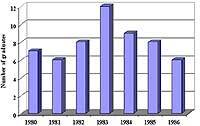 |
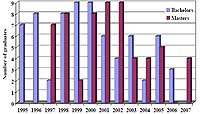 |
Figure 4: The history of nuclear engineers qualified from KTU from 1978 to 1986 [1].
Figure 5 indicates the personnel employed at the currently operating NPP Ignalina-2 and the workforce situation when it will be closed. It shows that people working in the Ignalina-2 NPP will continue the decommissioning process and remaining personnel will be available for the new power plant construction project.
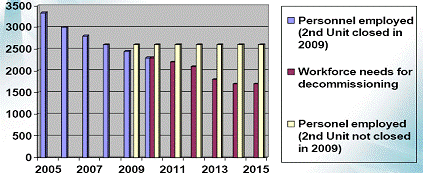
Figure 5: Plan for current and future NPP staff changes [1]
Russia has six decades of nuclear power history. After Chernobyl, the government minimised its support due to public pressure, which caused a mass departure of specialists from the nuclear industry. This was followed by a drastic reduction in technical service personnel, moral ageing and physical wearing of the equipment park. For example, in the 90’s, the Kurchatov Institute lost about half of its staff. Other scientific institutions have simply disappeared. This situation also affected competition in the nuclear field and other technical professions. Parallel to this, the young generation showed growing interest in emerging fields of economy and law, which led to a further decline in nuclear education. The collapse of the Soviet Union led to some research centres, important to the whole picture, to break up and become much weaker. These centres include the Kharkov Physics & Engineering Institute in Ukraine (radiation material science), the Belarus Nuclear Centre (originally the centre of fast reactor development), the Kazakhstan experimental base with its unique pulse reactor and others.
A recent analysis of the age of nuclear specialists in Russia has shown that over a half of the country’s nuclear R&D professionals are older than 50. The number of young people (up to 30 years old) active accounts for only 10-15% - and this age group has reduced 2-3 fold in the last 15 years, while the age group over 60 has increased by the same factor. The situation in the Kurchatov Institute is almost similar. It should be noted that in nuclear industry, where the salaries are considerably higher, the situation is less critical: the rate of workers over 50 makes 20- 30%, and workers younger than 30 are about 20% [6].
The main reason for the interest of students in nuclear careers are the Russian R&D Institutes of the RFAAE and scientific departments at nuclear power plants. Nearly 800 students graduated with MEPhI annually and find jobs in nuclear science and industry. Annual graduation rates for specialists in nuclear engineering from the leading Russian universities during 1999–2001 are shown in Figure 6.
OINPE: Obninsk Institute of Nuclear Power Engineering.
TPU: Tomsk Polytechnical University.
USTU: Ural State Technical University (Ekaterinburg).
NSTU: State Technical University (Nizhnyi Novgorod).
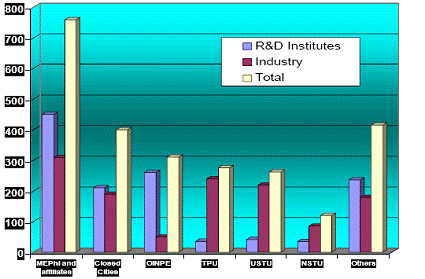
Figure 6: Amount of alumni signed on for nuclear enterprises during 1999–2001[1].
Russia has survived the “crisis decade.” An increase of about 1.5% in nuclear energy production was observed from 1998 to 2003. Further improvement has occurred since then [6]. This was made possible because the Russian nuclear sector has managed (though with considerable losses) to preserve its organisational unity, science base, high level of technological expertise and potential. The principles laid down during its establishment, including those relating to scientific knowledge management, have proven to be highly sustainable in crisis conditions.
The educational system for nuclear engineering, like that in any other knowledge area, includes training activities that are only limited by Russian legislation. Figure 7 show that the nuclear engineering education system is a multi-level structure oriented towards the possible needs of industrial sectors.
Both forms of education system (i.e. the specialists training and two-step education systems) are being implemented simultaneously at MEPhI. Throughout the first five semesters of the specialists’ training course, students study the fundamental concepts of physics, mathematics, and basic engineering and computer-associated disciplines. The next four semesters are devoted to specialisations and to in-depth learning of special engineering skills. The training for nuclear students starts as of the sixth semester. Compulsory participation in the training research takes place under supervision of highly-experienced instructors from MEPhI or at leading nuclear R&D institutes. The practical experiments that accompany practically all profiling courses are given greater importance.
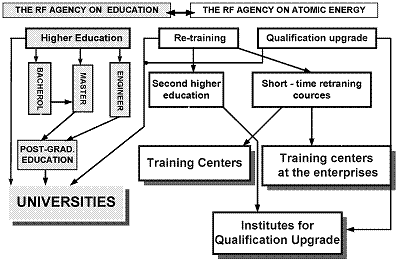
Fig. 7: Structure of the nuclear engineering educational system in Russia [6].
The Russian higher education institutions that are presently involved in training specialists in nuclear engineering [6] are as follows:
Moscow Engineering Physics Institute (MEPhI) – the basic university of the RF Agency on Atomic Energy (RFAAE)
three MEPhI affiliates at the closed cities
four educational institutes at the closed cities
particular departments at 12 Russian universities
post-graduate education at the above-mentioned universities and on the basis of more than 20 R&D institutes of the RFAAE
re-training and qualification upgrades at six qualification upgrade institutes of the RFAAE and at special departments at certain universities
Four military universities
The “Slovakian Electricity State Utility” (SE) operates four VVER 440/213 NPPs in Slovakia at two sites, in Bohunice and Mochovce. In February 2007, SE announced that Italy will finance the completion of Mochovce 3&4, partially finished VVER 440/213 reactors that are scheduled to be completed by 2012 and 2013.
The Faculty of Electrical Engineering and Information Technology (FEI) of the Slovak University of Technology (STU) offers two branches of nuclear education i.e. Nuclear Power Engineering and Material Science Engineering. It offers undergraduate (BSc), graduate (MSc), post graduate (PhD) courses, as well as training programmes related to nuclear technology.
It also organizes IAEA regional training courses for safety, management and the use of research reactors for young experts from various European countries. STU, in collaboration with three other universities (Budapest University of Technology, the Czech Technical University in Prague and the Vienna University of Technology, VUT) has organised for several years the Eugene Wigner course supported by ENEN. The educational trends of STU are shown in figure 8 [1].
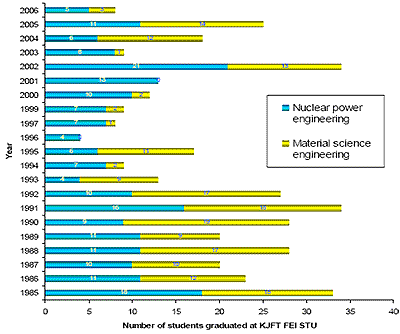
Fig. 8: The trends of nuclear programmes at STU
The institutions of the country which are involved in nuclear education are the Slovak University of Technology and the Slovakian Nuclear Power Plant Research Institute (VUJE). The former awards academic degrees, while the latter is a training centre that offers both theoretical preparation and the practical training of NPP personnel on simulators.
The educational programme on offer in the UK is presented in figure 9, which shows the existing academic courses with their duration [1].
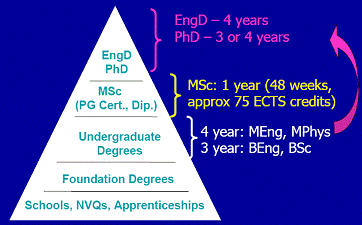
Fig. 9: Academic courses (undergraduate & postgraduate) at UK universities
Over the last two decades, a number of nuclear research courses were ended due to many factors, mainly lack of industry interest, the low rate of student enrolments, etc. The decline in the UK’s R&D manpower available to the industry and in public funding for fission research is shown in figures 10 and 11 [1].
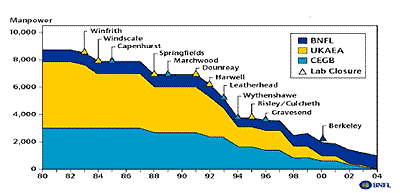
Fig. 10: The decline in UK R&D Manpower available to the Industry and laboratory closures
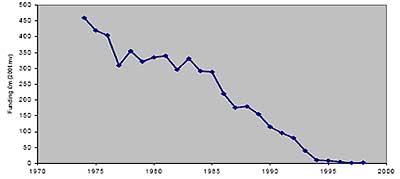
Fig. 11: The decline in UK public funding for R&D of fission research
Recently, the following studies/surveys to determine the status of nuclear education have been made:
HSE/NII Education & Research in British Universities (2002)
DTI Nuclear Skills Group (Coverdale, 2002)
Nuclear Task Force (Ruffles, 2003)
COGENT Nuclear employers survey (2005)
NDA Health Physics Resources in UK Industry (Rankine, 2007)
The 2002 HSE/NII study on nuclear education in British universities concluded that:
If nuclear education were a patient in a hospital it would be in intensive care.
Its health seems to depend more on the enthusiasm of individuals than the commitment of institutions.
Although nuclear courses are taught at 22 of the 130 or so universities in the UK, the level of nuclear teaching is very low at many of them and at seven universities teaching is likely to disappear altogether in the next few years.
Compared to the number of science, engineering and technology students, the number of those following nuclear education courses represents a small percentage.
An increase in the number of courses with a nuclear content at both postgraduate and undergraduate levels has failed to produce a corresponding increase in the number of students.
There is a worrying decline in the already small number of students pursuing 100% nuclear postgraduate courses.
Nuclear education at the undergraduate level has been reduced to the level of “taster courses” within mainstream science degrees.
In many universities the facilities for nuclear teaching are outdated and such an image of decay is unlikely to attract students.
It is interesting to note here that although the UK operates 19 nuclear power plants and decided recently to expand its nuclear park over the next decades with new NPPs - all its civilian research reactors have been closed down, which leaves a vacuum in the possibilities for practical education and training in the nuclear field for UK students. Therefore, the Nuclear Technology Education Consortium (NTEC www.ntec.ac.uk) signed a contract with the Atominstitute Vienna/Austria to carry out two one-week practical training courses per year at the TRIGA Mark II reactor in Vienna for NTEC students.
The need to preserve, enhance or strengthen nuclear knowledge is recognised worldwide and to achieve this ambitious objective networking among nuclear institution is being done. Due to the space limits of this paper, the developed networks (national & regional) are only mentioned in passing. Their details can be found via the web links given below.
EU National Networks
Belgium Nuclear Higher Education Network (BNEN) [9]
Consorzio Interuniveritario per la Ricerca Tecnologica Nucleare (CIRTEN), Italy [12]
Nuclear Technology Education Consortium (NTEC) [10]
EU Regional Networks
European Nuclear Education Network (ENEN) [11]
Nuclear Energy Agency (NEA) [7]
To combat the current situation facing nuclear education and training, some best practices used in member’s countries were studied. These common best practices, which maintain the current status of these entities and ensure the smooth functioning and improved quality of operations, have been discussed in this paper. Furthermore, the recommendations for improving the manpower problem have also been described. These practices can be grouped into following six categories:
It was found that there is imbalance between the supply and demand for a nuclear work force in many member states. In many OECD member countries, the important factor that explains the gap here is the low rate of student enrolments, which in turn is due to negative student perceptions. This low enrolment level affects the budget, which affects the facilities offered for nuclear courses and causes a running down of nuclear courses offered. In fact, these two factors (i.e. low enrolment and the number of available nuclear courses) feed each other. This declining in the number of enrolled students is a prime target for remedial action.
To counter this low enrolment trend it has been acknowledged that basic knowledge of nuclear science should be taught at secondary education level. It would be good practice to seek to produce future nuclear graduates by starting at a very basic level. Though this is a long-term goal it will influence the process of nurturing and recruiting the nuclear workforce for the following reasons:
It is easier to attract young people towards nuclear education when they have already some fundamental nuclear knowledge. This is only possible if they already receive a basic understanding at secondary education level. Most students decide about their future career when they have finished secondary education. A basic knowledge of nuclear technology can help them to select this as a future career option. It would also strengthen the decision- makers (politicians, economists, journalists etc) at national and international levels if they were to already possess such basic knowledge of nuclear technology.
The strong link between education and training has been recognised as a means of promoting cooperation between the two. They can be linked strongly by common course content that enables both of institutions to share both theoretical and experimental expertise. Most students enroll in a training course for which they receive an academic certificate. It is clear that there must be common course content so that students having an academic degree in relevant subject with good theoretical background may better retain what they have learned during training
In most of the member states universities are facing a decline in available facilities and faculties. In the workplace the nuclear expert workforce is ageing and many people are expected to retire very soon. Nuclear societies world-wide are concerned about the sustainability of nuclear societies not because of a lack of knowledge, but because of lack of young members to take over from those about to retire. Because it is the industry that most needs a trained work force to keep its facilities going and well operated there is general consensus for industry to provide support beyond current funding levels. The institutional co-operation between academia and industry would help meet the challenge of human resources in the nuclear sector.
It is common practice for governments to give financial support and funding is directed towards education and research as an investment in long-term future planning. Most nuclear scientists/engineers are employed in three broad categories i.e. industry, academia (which includes universities, colleges etc), government agencies and other organisations.
With significant funding support academia can offer more courses to meet demand. Because governments want nuclear courses and strategies to sustain nuclear competence, it is, therefore, the responsibility of governments to devise and implement national policies for sustaining the future nuclear workforce.
Close analysis shows that governments, academia and industries are strongly linked with respect to their goals. The public sector supplies students to educational institutions (academia) and these institutions provide a workforce for industry. In turn, industry provides services to the public and again plays a role in persuading students to opt for a nuclear education. Governments, in the public interest, need to make aware and convince citizens of the importance and interest of nuclear education.
For educational institutions, networking has been widely recognized as a key strategy for capacity building and better use of available educational resources. By networking expertise, information and facilities can be exchanged. On the line of NKM, the networking has become an important element of nuclear education and training. In practice, its benefits have been acknowledged, and networks are being established at all levels i.e. national, regional and global levels. Networking might even become more important in the future, both in terms of the extent and depth of co-operation.
Networking establishes and promotes national and international collaboration in educational and/or training programmes. If there is an essential lack of expertise in one country, then networking can help access to its provision in another country and should be encouraged.
Similar to an industrial product, the quality of education and training is an important measure of the achievement of any academic system. Every education system, like industry, must have its own quality management system. The most important factor, quality management, is at the core of the academic curriculum. To take up the ambitious challenges of offering top quality in nuclear education, new, attractive and relevant curricula, higher education institutions should cooperate with industry, regulatory bodies and research centres. More appropriate funding from public and private sectors is necessary too.
An example of a standard integrated curriculum is that offered by ENEN. The NEPTUNO programme, part of the 6th European Frame Work Programme, integrates European education and training in nuclear engineering, nuclear safety and other nuclear fields with the major objective of securing qualified curricula in nuclear sciences at European universities. It also aims to achieve harmonization, to ensure mutual recognition according to the Bologna Declaration, and to harmonise professional training and accreditation schemes.
As an example, ENEN is focussing on a good quality assurance system for its academic courses using it’s Quality Assurance Committee, which examines the quality assurance practices adopted in partner institutions. The ENEN Master of Nuclear Engineering (i.e. EMSNE) certification meets the objectives and quality standards set by the ENEN Association. This certification is a guarantee that the Masters level education received is of the highest quality available in Europe.
ENEN, on behalf of its members, grants the quality label European Master of Science in Nuclear Engineering if a substantial amount (some 20 or 30) of credits have been achieved at an ENEN-member institution other than the home institution. Typically, these credits might be obtained by performing a project work or Masters thesis and or by enrolling in related advanced nuclear courses abroad.
There is a big difference between governmental and industrial perspectives with respect to their respective interests. Firstly, there is the time horizon. Industries, by necessity, are driven by the business motives and, therefore, they have short term vision (i.e. a few years ahead). Governments, on the other hand, are more driven by the need to act in accordance with the national welfare requirements and obviously have a much longer time perspective (i.e. a few decades or even longer). It is important to differentiate between the actions or the motivations of governments and those of industry. Another difference is related to the scope of R&D that is supported. Industry works in a competitive environment and, therefore, industry driven R&D is more directed towards customising the existing knowledge base, the existing R&D base, to a particular product, goods or services. Government supported R&D is inherently more generic in nature and combined with the long-term objective of addressing the core issue of development.
Beyond the funding issue, industry should provide access to facilities for experimental training for students. Similarly, industry can help by attracting the students. The public and potential students need to be aware that the industry is moving forward. It is also important to note that universities, in co-operation with industry, can attract good caliber students if they offer some career-oriented exciting and innovative educational courses.
As a result of these best practices, the following recommendations can be made:
To reduce the supply/demand imbalance it is recommended to develop more innovative R&D programmes and enhanced university courses. The universities should design and offer attractive academic courses with high quality curricula in order to present a dynamic image of the industry to those looking for career choices. The performance based training of nuclear power plant personnel has been recognised as essential for the successful management of human resources in the nuclear sector. To manage the demand/supply balance the nuclear industry needs to identify what competences it is going to need, in the short-term, as well as the medium- to long-term, and must work with universities to ensure that nuclear courses are in place to meet those needs.
With regards to institutional cooperation, education and training institutions have been considered to be workforce suppliers to industry and other R&D organisations. Their co-operation in providing basic and attractive education and rigorous training play a significant role to meet their specific needs.
The role of government, academia and industries and how they must collaborate is emphasised. Governments should expand their strategic energy planning to increase the level of public awareness of nuclear education, manpower issues and infrastructure. Convincing the public through print and electronic media about the safe and efficient use of nuclear technology will help raise the student enrolment rates at universities.
The EU is urged to facilitate the transferability of education and skills between its member countries, especially in critical nuclear specific disciplines.
Funding is recognised as an important element. It is recommended that both industry and government should think beyond funding support alone towards encouraging nuclear knowledge management and its preservation. Access to national laboratories and industrial facilities should be provided for students to carry out experiments and practical work.
The quality of curricula is a key a element in improving and developing the quality of nuclear education. The educational and training systems must put into practice good quality management systems. A good example in this regards, which has been described in the previous sections, is that of ENEN.
The safety of nuclear installations, waste management and the radiation protection are major public concerns. It is recommended that international initiatives for sharing nuclear safety knowledge through networks, documentation and tools be expanded.
Conclusion
Due to negative public perceptions, the increasingly large number of retirements of qualified workers, minimal governmental planning and a decrease of interest in industry, a lack of qualified personnel for the nuclear power industry has been identified. The European Commission, within its 5th EURATOM Research and Training Programme on nuclear energy, supported the ENEN project as a nuclear model project. The present level of qualified nuclear employees is unsatisfactory in the short term. This paper presented the status and patterns of nuclear education in the member states. By an analysis of best practices being carried out in EU members and the implementation of recommendations put forward we may once again revitalise the nuclear education and training portfolio in the EU.
References
IAEA Technical Meeting on the “Role of Universities in Preserving and Managing Nuclear Knowledge”, 10-14 December 2007, IAEA Hq., Vienna, Austria
H. Böck and M. Villa, ‘Management of Nuclear Knowledge on an international scale using small university research reactor’, IAEA publication, IAEA-CN-153/4/P/28.
World Nuclear Association, web page: www.world-nuclear.org
National Institute for Nuclear Science and Technology (INSTN), web page: www-instn.cea.fr/rubrique-uk.php3?id_rubrique=23
“Public information and education in nuclear science and engineering in Germany” by Fritz P.and Radloff D, www.pacificnuclear.org/pnc/2006-Proceedings/pdf/0610015final00023.pdf
“Nuclear education in Russia: status, peculiarities, problems and perspectives“, by Boris N. Onykiy and Eduard F. Kryuchkov, Int. J. Nuclear Knowledge Management, vol.1, No. 4, 2005.
Nuclear Energy Agency NEA, web page www.nea.fr
OECD publication 2000 ‘Nuclear Education and Training: Cause for Concern?’, OECD / NEA, ISBN 92-64-18521-6.
Belgian Nuclear Higher Education Network, BNEN, www.sckcen.be/bnen
Nuclear Technology Education Consortium, NTEC, www.ntec.ac.uk/
European Nuclear Education Network ENEN, web page: www.enen-assoc.org/
Consorzio Interuniveritario per la Ricerca Tecnologica Nucleare (CIRTEN), Italy, web link: www.enen-assoc.org/en/about/enen-membership/effective-member/cirten.html
“The role of networking for nuclear education” by P. Gowin, Y. Yanev, IAEA-CN-123/05/O/08.
“Trends in nuclear education“ J. Lartigue, T. Martínez, Journal of Radioanalytical and Nuclear Chemistry, Vol. 276, No.3 (2008) 849–855 0236–5731.
PIME 2008 - Defining tomorrow's vision of nuclear energy, www.pime2008.org
IAEA TECDOC 1234 “The Application of Research Reactors”
![]()
© European Nuclear Society, 2009